If you’re on the shorter side and find yourself straining to reach the desk or feeling uncomfortable in your office chair, you’re not alone. A chair that’s too low can cause all sorts of issues—from poor posture to unnecessary back and leg strain. The good news? With a few simple adjustments, you can easily make your office chair taller and more comfortable without needing to invest in a whole new one.
Key Takeaways
- Adjusting your office chair’s height is essential for comfort and proper posture, especially for short users.
- Start by using built-in mechanisms like seat height levers, and consider accessories like footrests and seat cushions for added support.
- If adjustments aren’t enough, replace components like the gas lift cylinder or casters to achieve the ideal height.
- Regularly check your chair setup to prevent discomfort and potential health effects.
In this article, we’ll explore practical tips and solutions to make an office chair taller for short users. From easy adjustments to creative modifications, these tips will help you achieve an ergonomic setup that promotes comfort and productivity.
Understanding the Importance of Proper Chair Height
Finding the right chair height is crucial for short individuals, as it directly impacts posture, comfort, and overall well-being. The ideal chair height ensures that the user’s feet rest flat on the floor, knees are bent at a 90-degree angle, and thighs are parallel to the ground. This alignment helps distribute body weight evenly, minimizing pressure on the lower back and thighs.
For shorter individuals, a standard office chair may not meet these ergonomic requirements. Without adjustments, sitting on a chair that’s too high can leave your feet dangling. According to ergonomic guidelines, the key is to create a seating position that allows for natural posture and proper blood circulation.
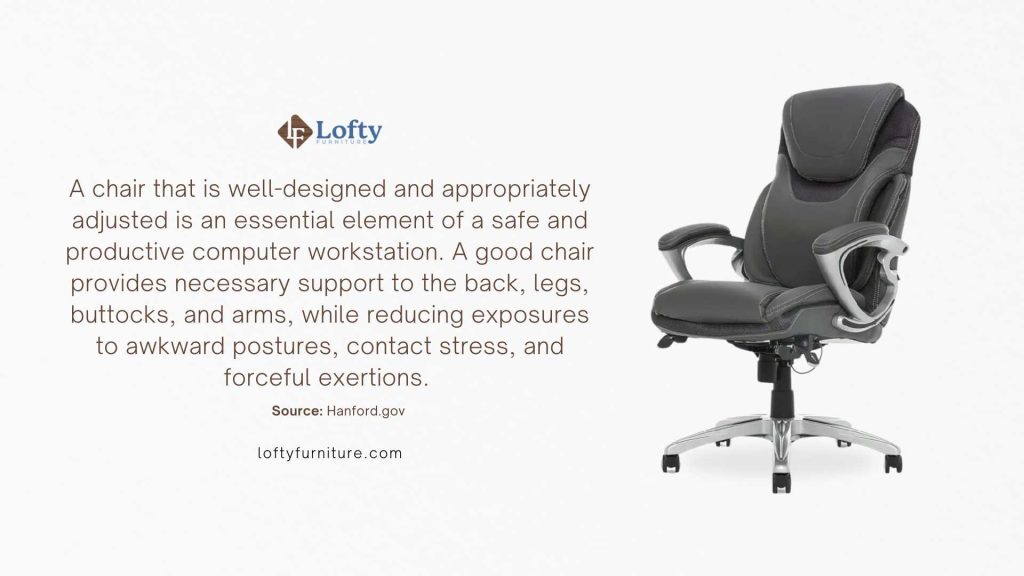
Source: Hanford.gov
Assessing Your Current Office Chair
Evaluating your current office chair is the first step toward creating a setup that supports proper posture and comfort for shorter users. Start by checking key features like adjustable seat height, seat depth, and footrest compatibility. The ability to adjust the seat height is crucial, as it ensures your feet rest flat on the floor and your knees maintain a 90-degree angle. Additionally, assess the seat depth to ensure it supports your thighs without pressing into the back of your knees—leaving a 2–3 inch gap is ideal. If the seat height cannot be lowered sufficiently, consider whether your chair is compatible with an adjustable footrest to provide proper support and alignment.

Signs of an improper chair height often include dangling feet, discomfort behind the knees, or uneven pressure on the thighs. Poor posture, slouching forward, or leaning awkwardly can also indicate that the chair height isn’t optimal.
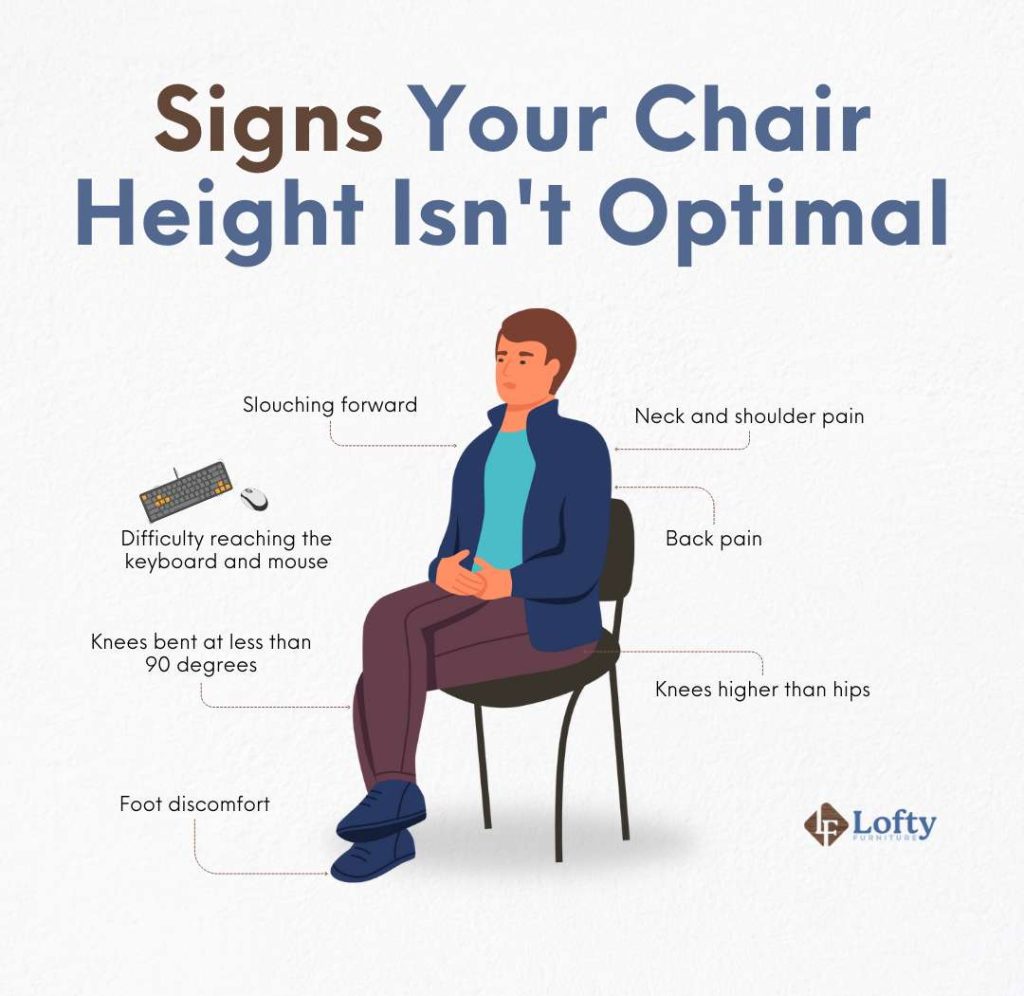
How to Make an Office Chair Taller for Short User
If your office chair feels too low, adjusting its height can make a big difference in both comfort and posture. Here are some simple and effective ways to raise your chair and create a more ergonomic workspace.
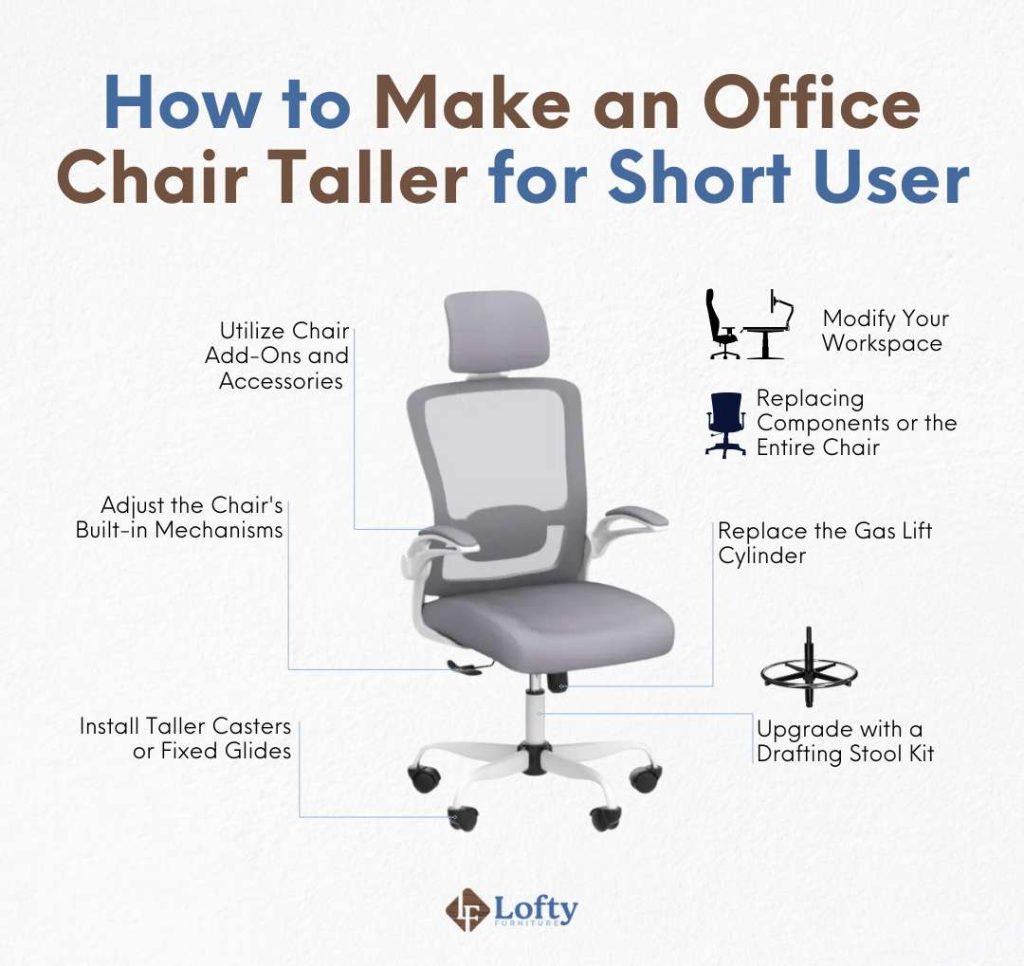
1. Adjust the Chair’s Built-in Mechanisms
The chair’s built-in mechanisms are the seat height, armrests, and lumbar support. Most modern office chairs come with these mechanisms that let you fine-tune the fit to your needs. One of the most important adjustments is the seat height, usually controlled by a lever or knob under the seat. This lets you raise or lower the chair so your feet can rest flat on the floor, which is key for good posture. Many chairs also have adjustable armrests that you can move up or down for better arm support. And don’t forget about the lumbar support – adjusting it can help prevent sore back and keep you comfortable throughout the day.
2. Replace the Gas Lift Cylinder
The gas lift cylinder, which controls seat height, can wear out over time and fail to hold the chair at the desired height. If the chair’s adjustments aren’t cutting it, consider replacing the gas lift cylinder. Over time, these cylinders can wear out and stop holding the seat at the right height. To make your chair taller, you can swap the old cylinder for a taller one. The process is straightforward: remove the old cylinder from the chair’s base, usually with a tool to disconnect it from the seat mechanism. It’s a simple, budget-friendly fix.
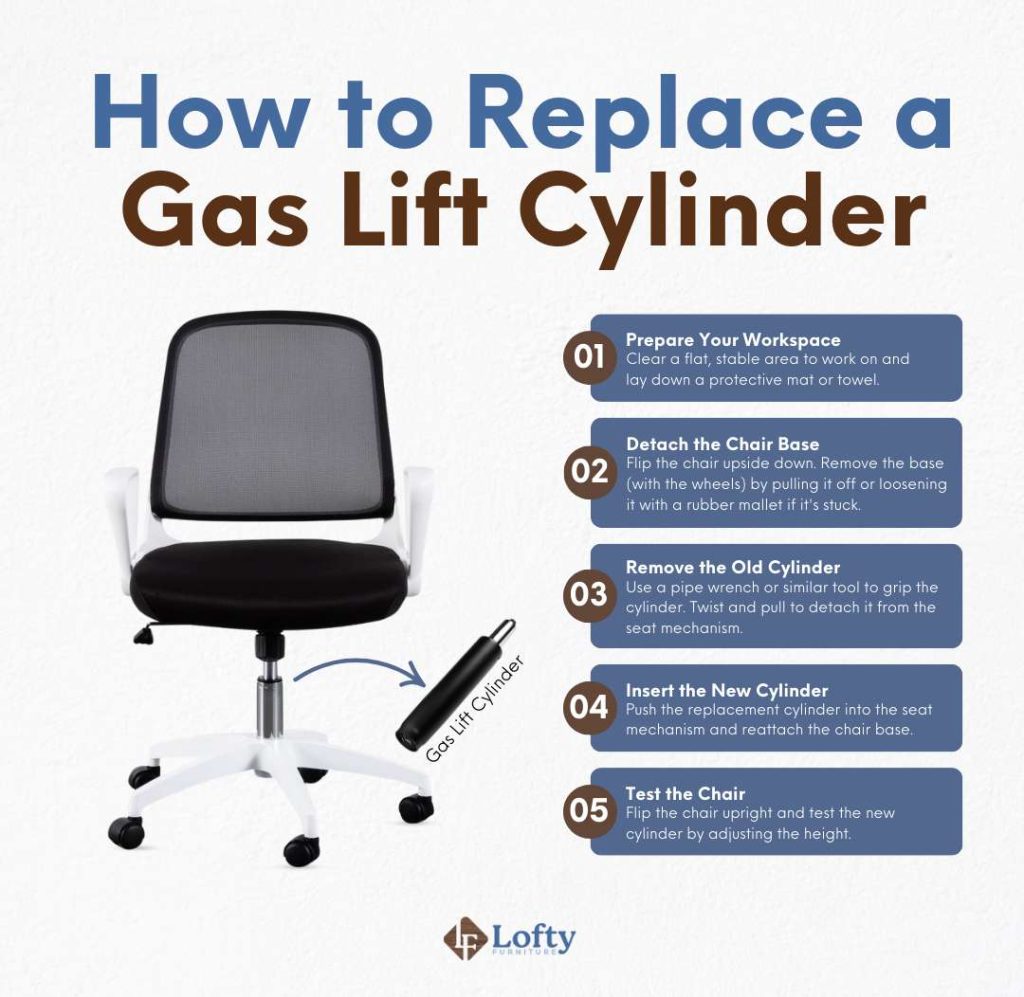
3. Install Taller Casters or Fixed Glides
Chair casters are the wheels attached to the base of your chair, allowing for smooth movement across the floor. Casters, or wheels, are another easy way to adjust your office chair’s height. Most standard chairs come with short casters, but swapping them for taller ones can add a few extra inches and improve mobility. If you prefer a stationary chair, you can replace the casters with fixed glides instead. Made from durable materials like plastic or metal, fixed glides provide a stable, non-moving base.
4. Upgrade with a Drafting Stool Kit
A drafting stool conversion kit typically includes a taller gas lift cylinder that provides more height than a standard office chair gas lift. For users who require additional height for specific tasks, such as working at high desks or standing workstations, upgrading to a drafting stool kit can be an ideal solution. Additionally, many kits come with a footrest ring, which adds extra comfort by giving your feet a place to rest while sitting at a higher position. This upgrade is perfect for workstations that require flexibility, such as those in laboratories, art studios, or adjustable standing desks.
5. Use Chair Add-Ons and Accessories
In addition to making direct adjustments to your office chair, there are several add-ons and accessories that can help you achieve the optimal height and comfort. For example, adding a seat cushion can help elevate your seating position while also providing extra comfort. Additionally, lumbar support cushions can be placed on the chair’s backrest to improve lower back support, which helps promote proper posture and reduce back pain. Footrests are another essential accessory for short users. These simple accessories are cost-effective solutions that can enhance the ergonomics of your existing chair without requiring major modifications.
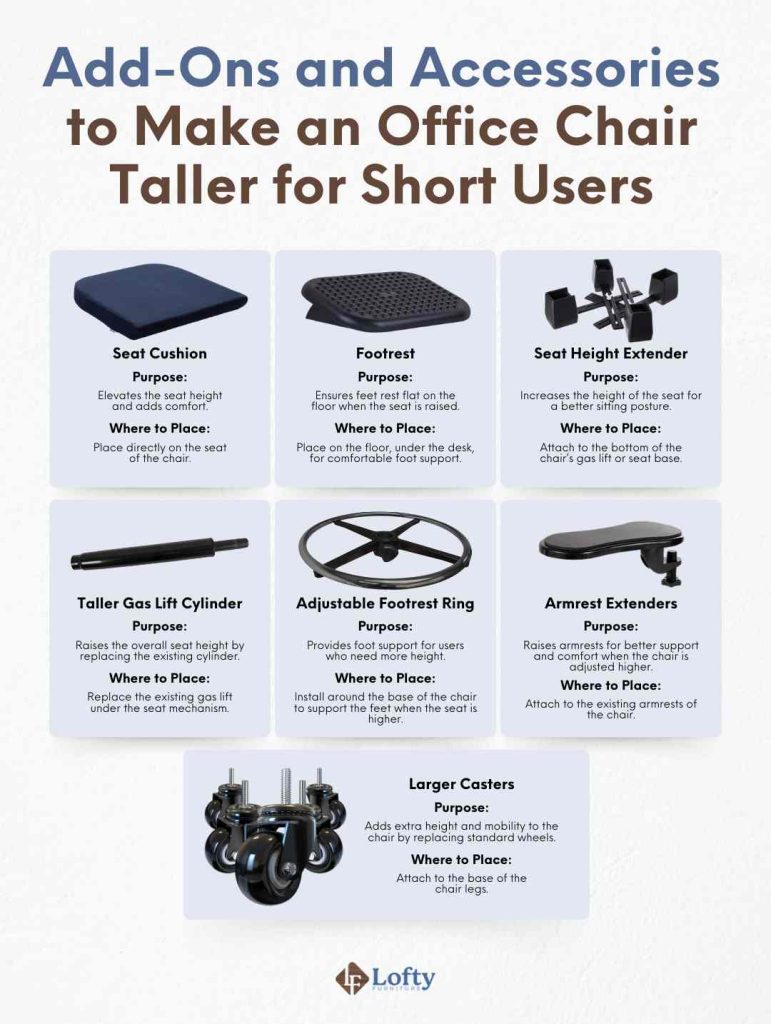
6. Modify Your Workspace
Sometimes, adjusting your workspace can complement the changes made to your chair. One of the first adjustments to consider is the desk height. If possible, adjust the desk height to align with your chair, ensuring that your arms rest comfortably at a 90-degree angle when typing. Another useful modification is the addition of keyboard and mouse trays, which can be mounted underneath your desk to create a more ergonomic typing posture. Similarly, adjusting the monitor height can have a significant impact on your posture. Ensure that your monitor is at eye level to prevent neck and eye strain.
7. Replacing Components or the Entire Chair
There may come a point when replacing components or even the entire chair is necessary. If your chair lacks the necessary height adjustments or ergonomic features, investing in a chair designed specifically for shorter users could be the most effective solution.
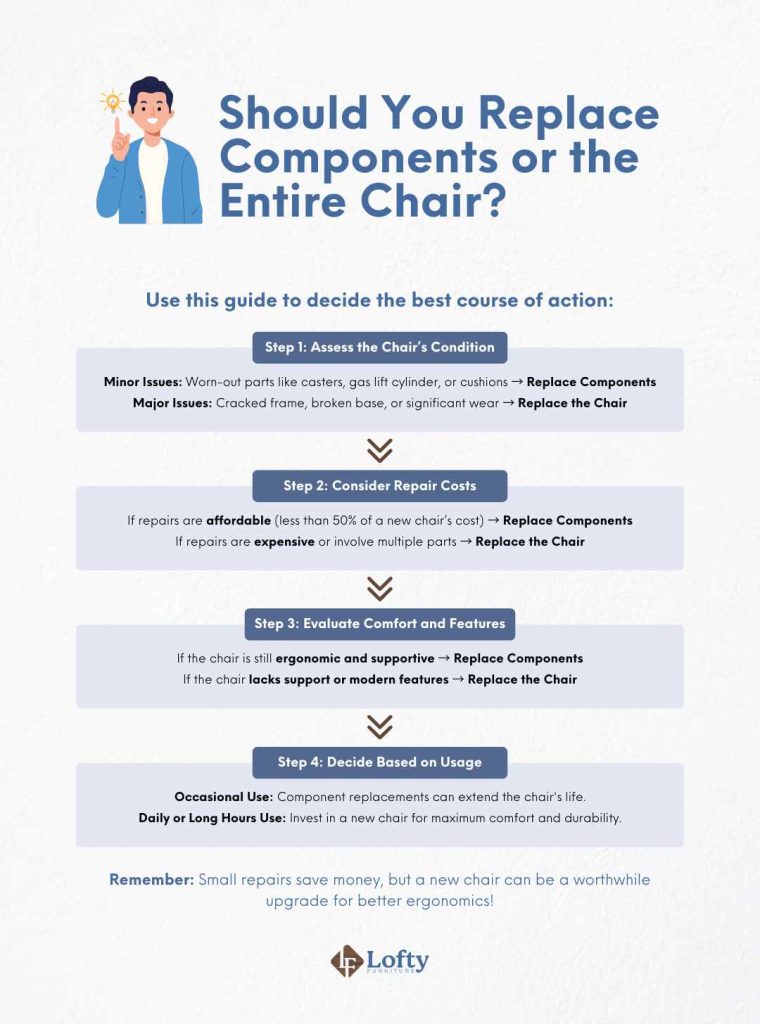
Invest in your well-being with an ergonomic office chair. Find your ideal fit today!
Conclusion
Making an office chair taller for a short user is a simple yet highly effective way to improve comfort, posture, and overall productivity. By adjusting your chair’s built-in mechanisms, utilizing chair add-ons like footrests and cushions, or even replacing components like the gas lift or casters, you can create a customized seating experience that promotes ergonomic benefits. Remember, it’s crucial to consider all aspects of your workspace, including desk and monitor height, to ensure that your entire workstation is aligned for maximum comfort and efficiency.
FAQs
1. Are there specific chair models designed for shorter users?
Yes, these chairs usually feature a lower seat height range, smaller seat pans, and shorter backrests to provide better support and comfort. Look for chairs labeled as “petite” or “short-user” chairs, which are built with adjustable mechanisms.
2. What are the risks of modifying an office chair improperly?
Improperly modifying an office chair can lead to several issues, including unstable seating, which may increase the risk of falls or injury. Incorrectly replacing components like the gas lift or using unsuitable add-ons could result in discomfort, misalignment, or poor posture. It’s important to follow proper guidelines when making adjustments.
3. Can I use a stack of books as a chair riser?
While stacking books may provide a temporary solution for raising your chair, it’s not a safe or long-term option. It’s better to use proper chair risers or invest in big and tall office chair and adjustable components designed for height adjustments to ensure safety and comfort.
4. How often should I adjust my chair height?
You should adjust your chair height as needed, especially if you experience discomfort or strain. Ideally, adjust it once to find the optimal height for your body, ensuring your feet are flat on the floor and your knees are at a 90-degree angle. If your workspace or tasks change, or if you’re using different equipment, it may be necessary to re-adjust your chair height to maintain comfort and ergonomic alignment.
